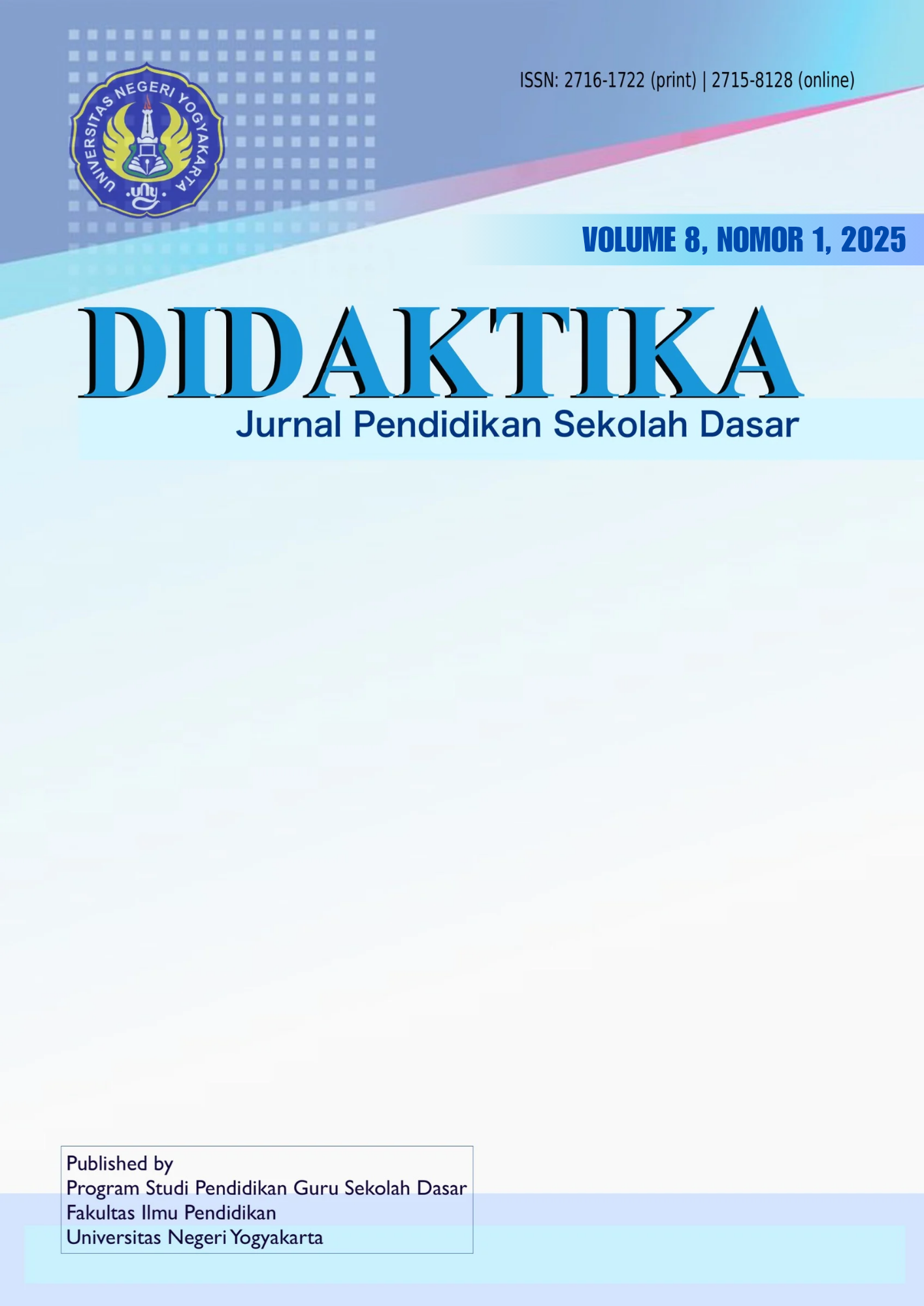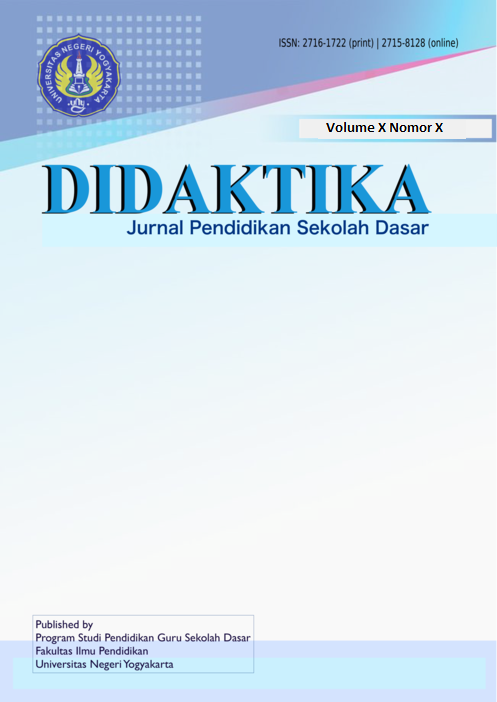The Effect of Discovery Learning Model Based on Augmented Reality Media on Students' Critical Thinking Skills
Abstract
This study aims to examine the effect of the DINAR (Discovery Learning based on Augmented Reality) model on the critical thinking skills of grade V Madrasah Ibtidaiyah students on the material of human respiratory organs. The method used was quasi-experimental with a non-equivalent control group design, involving 48 students divided into experimental (DINAR learning) and control (conventional method) groups. This research was conducted at MIS Raudlatul Mutaallimin, Pakis, Bringin District, Semarang Regency. Data were collected through critical thinking tests based on analysis, evaluation, and inference indicators, and analyzed using parametric statistical tests (Independent Sample T-Test) and N-Gain. The results showed a significant increase in the experimental group with an average posttest of 156.8 (versus 133.2 in the control). The T-Test produced a value of t(46) = -5.836 (p = 0.000), indicating a highly significant difference. N-Gain analysis reinforced these findings with an effectiveness score of 57.49% (moderately effective) in the experiment, while the control only reached 38.52% (less effective). The integration of Augmented Reality in Discovery Learning facilitates 3D visualization of respiratory organs, allowing students to explore concepts interactively and build independent understanding. This finding is in line with Bruner's theory of constructivism, asserting that a combination of immersive technology and explorative approaches effectively improves critical thinking skills. This study recommends the adoption of the DINAR model in science learning, particularly for abstract materials, as well as teacher training in AR-based media development.
References
Afnan, M. Z., & Puspitawati, R. P. (2024). Exploration of biological concept understanding through augmented reality: A constructivism theory approach. JPBI (Jurnal Pendidikan Biologi Indonesia), 10(3), 1139–1147. https://doi.org/10.22219/jpbi.v10i3.36896
Amalia, N. R., Sihotang, I. P., Nurhayani, N., & Sam, S. R. (2023). Pengaruh Media Augmented Reality terhadap Kemampuan Berpikir Kritis Siswa Sekolah Dasar. FONDATIA, 7(1), 41–51. https://doi.org/10.36088/fondatia.v7i1.2914
Arena, F., Collotta, M., Pau, G., & Termine, F. (2022). An overview of augmented reality. Computers, 11(2), 28. https://doi.org/10.3390/computers11020028
Arifuddin, A., Wahyudin, W., Prabawanto, S., Yasin, M., & Elizanti, D. (2022). The effectiveness of augmented reality-assisted scientific approach to improve mathematical creative thinking ability of elementary school students. Al Ibtida: Jurnal Pendidikan Guru MI, 9(2), 444–455. https://doi.org/10.24235/al.ibtida.snj.v9i2.11647
Arikunto, S. (2013). Prosedur Penelitian suatu Pendekatan Praktik. Rineka Cipta.
Aswan, D. (2024). Analisis Kebutuhan Pengembangan Buku Interaktif Berbasis Augmented Reality (AR) untuk Meningkatkan Minat Baca Anak-Anak. Jurnal Ilmiah Wahana Pendidikan, 10(10), 916–922. https://doi.org/10.5281/zenodo.11541481
Azrai, E. P., Rini, D. S., Kurnianto, M. B., & Ampang, J. (2023). Ar sinaps: augmented reality learning media to enhance critical thinking ability. International Journal of Education. https://doi.org/10.17509/ije.v16i2.50329
Creswell, J. W. (2018). Research Design: Qualitative, Quantitative, and Mixed Methods Approaches (5th ed.). Los Angeles: SAGE Publications.
Damopolii, I., Paiki, F. F., & Nunaki, J. H. (2022). The Development of Comic Book as Marker of Augmented Reality to Raise Students’ Critical Thinking. TEM Journal, 348–355. https://doi.org/10.18421/tem111-44
Fadila, Z. N., Ratno, S., Nst, Z. F., Panjaitan, F. N., Hutapea, N. P. A., Gaol, M. K. L., … Olivia, H. P. (2024). Analisis Penerapan Model Pembelajaran Kreatif dan Inovatif Berbasis Hots di Era Digital. Jurnal Pendidikan, Bahasa Dan Budaya, 3(4), 125–134. https://doi.org/10.55606/jpbb.v3i4.4616
Faridi, H., Tuli, N., Mantri, A., Singh, G., & Gargrish, S. (2021). A framework utilizing augmented reality to improve critical thinking ability and learning gain of the students in Physics. Computer Applications in Engineering Education, 29(1), 258–273. https://doi.org/10.1002/cae.22342
Ghozali, I. (2018). Aplikasi analisis multivariete dengan program IBM SPSS 23.
Gunawan, D. M., Soekamto, H., Sahrina, A., & Suharto, Y. (2023). Pengaruh model discovery learning berbantuan video terhadap keterampilan berpikir kritis siswa. Jurnal Integrasi Dan Harmoni Inovatif Ilmu-Ilmu Sosial, 3(6), 626–635. https://doi.org/10.17977/um063v3i6p626-635
Hartanti, J., Hasiana, I., & Mufidah, E. F. (2024). Efektivitas Model Pembelajaran Berbasis Project (PBL) untuk Meningkatkan Kemampuan Berpikir Kritis Reflektif pada Mahasiswa. Utile: Jurnal Kependidikan, 10(2), 53–62. https://doi.org/10.37150/jut.v10i2.3140
Hidayat, M., & Sukari, S. (2025). Relevansi Kurikulum Pendidikan Islam di Madrasah dengan Kebutuhan Dunia Modern. Moral: Jurnal Kajian Pendidikan Islam, 2(1), 39–49. https://doi.org/10.61132/moral.v2i1.483
Hikmah, A. N., Chudzaifah, I., & Rohman, W. A. (2024). IMPLEMENTASI PENDEKATAN HEUTAGOGI: SELF-DETERMINED LEARNING UNTUK CALON GURU SD/MI. As-Sibyan, 7(1), 53–72. https://doi.org/10.52484/as_sibyan.v7i1.643
Iqbal, M., Purbiyanto, E., & Hamid, A. (2024). Aplikasi Augmented Reality Sebagai Media Pembelajaran Pengenalan Organ Tubuh Manusia Di Sekolah SDN Uungan Kecamatan Awayan Kabupaten Balangan. Indonesian Journal of Information Technology and Computing (IMAGING), 4(2), 218–232. https://doi.org/10.52187/img.v4i2.287
Istiqomah, F., Ayuningrum, A., Supriyanti, Y., & Yuhana, Y. (2024). Kemampuan Siswa Menyelesaikan Soal Higher Order Thinking Skills (HOTS) Pada Pembelajaran IPA di Kelas V SD. Pendas: Jurnal Ilmiah Pendidikan Dasar, 9(03), 535–545. https://doi.org/10.23969/jp.v9i03.16026
Khuriyathusyfah, N. F., & Muslim, A. (2024). Efforts to improve learning activity and learning achievement in mathematics through the discovery learning model in class iv-b of state elementary school 2 pliken. Jurnal THEOREMS (The Original Research of Mathematics), 9(1), 170–181. https://doi.org/10.31949/th.v9i1.10010
Marougkas, A., Troussas, C., Krouska, A., & Sgouropoulou, C. (2023). Virtual reality in education: a review of learning theories, approaches and methodologies for the last decade. Electronics, 12(13), 2832. https://doi.org/10.3390/electronics12132832
Muzdalifah, M., & Saputri, V. (2025). Penerapan Metode Nature School untuk Meningkatkan Keterampilan Observasi Siswa Kelas V MIS Nurul Yaqin. Katalis Pendidikan: Jurnal Ilmu Pendidikan Dan Matematika, 2(1), 323–338. https://doi.org/10.62383/katalis.v2i1.1332
Ngatminiati, Y., Hidayah, Y., & Suhono, S. (2024). Keterampilan Berpikir Kritis Untuk Mengembangkan Kompetensi Abad 21 Siswa Sekolah Dasar. Jurnal Review Pendidikan Dan Pengajaran (JRPP), 7(3), 8210–8216. https://doi.org/10.31004/jrpp.v7i3.30193
Putra, A. B. N. R., Mukhadis, A., Ulfatin, N., Tuwoso, T., Subandi, M. S., Hardika, H., & Muhammad, A. K. (2021). The Innovation of Disruptive Learning Media with Augmented Reality Based 3D Object Concept with Drill Machine Design to Improve Quality of Distance Learning in The Era of Education 4.0. Int. J. Interact. Mob. Technol., 15(12), 193. https://doi.org/10.3991/ijim.v15i12.21579
Rahayuningsih, S., Asrowi, A., Gunarhadi, G., & Ramli, M. (2024). Meta-Analysis Effectiveness of Using the Discovery Learning Model on Students’ 21st-Century Critical Thinking Skills. Jurnal Penelitian Pendidikan IPA (JPPIPA), 10(10), 685–692. https://doi.org/10.29303/jppipa.v10i10.8961
Rahman, A. (2023). The Effect of Discovery Learning on the Problem Solving Ability and Science Learning Outcomes in Elementary School Students. Journal of Education and Learning Innovation, 3(1), 52–58. https://doi.org/10.35877/454ri.eduline1431
Rahmatika, A. (2022). The Effect of Think-Talk-Write Cooperative Learning Assisted by GeoGebra Software on Students’ Critical Thinking (Case Study of SMA ALHIDAYAH Medan). IJEMS: Indonesian Journal of Education and Mathematical Science, 3(1), 1–8. https://doi.org/10.30596%2Fijems.v3i1.9877
Raj, T., Chauhan, P., Mehrotra, R., & Sharma, M. (2022). Importance of critical thinking in the education. World Journal of English Language, 12(3), 126–133. https://doi.org/10.5430/wjel.v12n3p126
Riduan, A., Suryani, I., & Lubis, P. H. M. (2024). Development of Augmented Reality Teaching Modules on Material Understanding Human Respiratory Organs Class V Elementary School. Jurnal Elementaria Edukasia, 7(3), 3047–3061. https://doi.org/10.31949/jee.v7i3.10402
Sari, Y., Abidin, Z., Kusumadewi, R. F., Ismiyanti, Y., & Ulia, N. (2024). Media Berbasis Augmented Reality Pada Pembelajaran IPAS Untuk Meningkatkan Berpikir Kritis Siswa Sekolah Dasar. JIP Jurnal Ilmiah PGMI, 10(2), 76–86. https://doi.org/10.19109/jip.v10i2.25572
Seibert, S. A. (2021). Problem-based learning: A strategy to foster generation Z’s critical thinking and perseverance. Teaching and Learning in Nursing, 16(1), 85–88. https://doi.org/10.1016/j.teln.2020.09.002
Solissa, E. M., Haetami, H., Yustita, V. V., Santosa, T. A., & Syafruddin, S. (2023). Effect Size Discovery Learning Model on Students Critical Thinking Skills. https://doi.org/10.33487/edumaspul.v7i2.6507
Sugiyono. (2019). Metode Penelitian Kuantitatif, Kualitatif, dan R&D (kedua). Bandung: ALFABETA.
Tusino, Dewi, P., & Sukarni, S. (2024). The Effects of Technology-Supported Project-Based Learning on EFL Learners’ Critical Thinking in Indonesia. The New Educational Review, 78, 139–151. https://doi.org/10.15804/tner.2024.78.4.10
Wulan, I. K., Afnani, K., & Anam, N. S. (2025). Pengembangan Modul Digital Interaktif Pada Materi Sistem Pernapasan IPAS Kelas V. Journal of Research and Publication Innovation, 3(1), 2483–2492.
Yuswantina, R., Dyahariesti, N., & Lestari, I. P. (2022). Optimasi Situ (Sistem Informasi Tuberculosis) Berbasis Integrasi Virtual dan Augmented Reality pada Kader PKK Desa Candirejo, Kabupaten Semarang. Indonesian Journal Of Community Empowerment (IJCE), 4(2), 176–182. https://doi.org/10.37303/likhitaprajna.v26i1.279
Downloads
Published
How to Cite
Issue
Section
Citation Check
License
Copyright (c) 2025 Muh Tubagus Naufal Fahmi, Suwardi, Choirul Anwar, Mildrett de Fatima Jalane

This work is licensed under a Creative Commons Attribution-ShareAlike 4.0 International License.
- Authors retain copyright and grant the journal right of first publication with the work simultaneously licensed under a Creative Commons Attribution License that allows others to share the work with an acknowledgement of the work's authorship and initial publication in this journal.
- Authors are able to enter into separate, additional contractual arrangements for the non-exclusive distribution of the journal's published version of the work (e.g., post it to an institutional repository or publish it in a book), with an acknowledgement of its initial publication in this journal.
- Authors are permitted and encouraged to post their work online (e.g., in institutional repositories or on their website) prior to and during the submission process, as it can lead to productive exchanges, as well as earlier and greater citation of published work.







